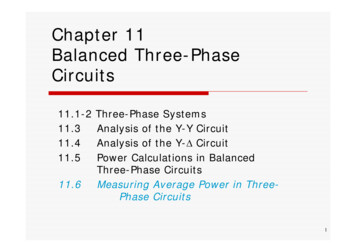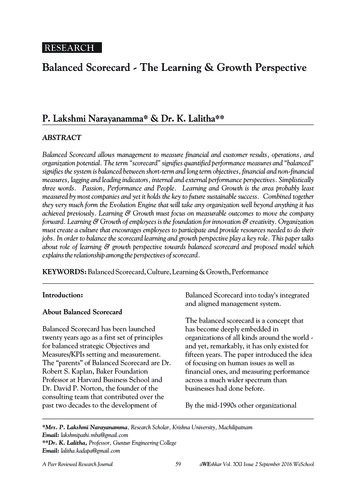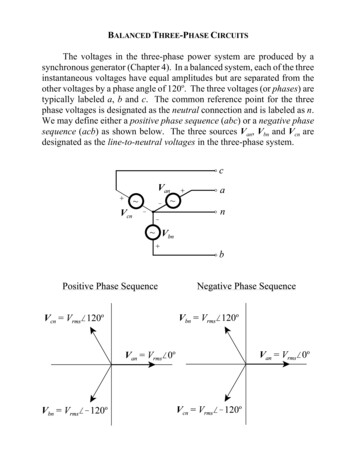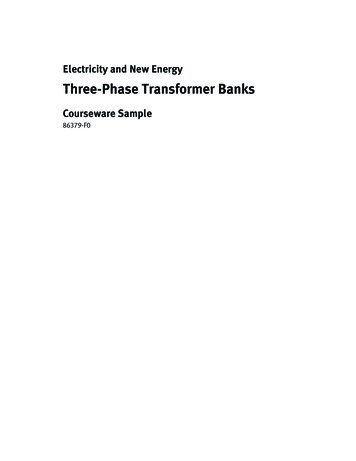
Transcription
Chapter 11Balanced se SystemsAnalysis of the Y-Y CircuitAnalysis of the Y- CircuitPower Calculations in BalancedThree-Phase CircuitsMeasuring Average Power in ThreePhase Circuits1
Overview An electric power distribution system looks like:where the power transmission uses “balancedthree-phase” configuration.2
Why three-phase? Three-phase generators can be driven byconstant force or torque (to be discussed). Industrial applications, such as high-powermotors, welding equipments, have constantpower output if they are three-phase systems(to be discussed).3
Key points What is a three-phase circuit (source, line, load)? Why a balanced three-phase circuit can beanalyzed by an equivalent one-phase circuit? How to get all the unknowns (e.g. line voltage ofthe load) by the result of one-phase circuitanalysis? Why the total instantaneous power of abalanced three-phase circuit is a constant?4
Section 11.1, 11.2Three-Phase Systems1.2.Three-phase sourcesThree-phase systems5
One-phase voltage sources One-phase ac generator: static magnets, onerotating coil, single output voltage v(t) Vmcos t.(www.ac-motors.us)6
Three-phase voltage sources Three static coils,rotating magnets,three output voltagesva(t), vb(t), vc(t).7
Ideal Y- and -connected voltage sourcesNeutral8
Real Y- and -connected voltage sources Internal impedance of a generator is usuallyinductive (due to the use of coils).9
Balanced three-phase voltages Three sinusoidal voltages of the sameamplitude, frequency, but differing by 120 phase difference with one another. There are two possible sequences:abc (positive) sequence: vb(t) lags va(t) by 120 .acb (negative) sequence: vb(t) leads va(t) by120 .1.2.10
abc sequence vb(t) lags va(t) by 120 or T/3. Va Vm 0 , Vb Vm 120 , Vc Vm 120 .11
Three-phase systems(Y or )(Y or ) Source-load can be connected in fourconfigurations: Y-Y, Y- , -Y, - It’s sufficient to analyze Y-Y, while the otherscan be treated by -Y and Y- transformations.12
Section 11.3Analysis of the Y-Y Circuit1.2.Equivalent one-phase circuit forbalanced Y-Y circuitLine currents, phase and line voltages13
General Y-Y circuit modelRef.The onlyessentialnode.14
Unknowns to be solved Line (line-to-line)voltage: voltageacross any pair oflines.Phase (line-toneutral) voltage:voltage across asingle phase.Line currentLine voltagePhasecurrentPhase voltageFor Y-connected load, line current equals phasecurrent.15
Solution to general three-phase circuit No matter it’s balanced or imbalanced threephase circuit, KCL leads to one equation:I 0 I aA I bB I cC , VNVa n VNVb n VNVc n VN (1),Z 0 Z ga Z1a Z A Z gb Z1b Z B Z gc Z1c Z CImpedanceof neutralline.Totalimpedancealong line aA.Totalimpedancealong line bB.Totalimpedancealong line cC.which is sufficient to solve VN (thus the entirecircuit).16
Solution to “balanced” three-phase circuit 1.2.For balanced three-phase circuits,{Va'n, Vb'n, Vc'n} have equal magnitude and 120 relative phases;{Zga Zgb Zgc}, {Z1a Z1b Z1c}, {ZA ZB ZC}; total impedance along any line is the sameZga Z1a ZA Z .VN Va n VN Vb n VN Vc n VN , Eq. (1) becomes:Z0Z Z Z 1 Va n Vb n Vc n3 VN 0, VN 0. Z ZZ 0 17
Meaning of the solution VN 0 means no voltage difference betweennodes n and N in the presence of Z0. Neutralline is both short (v 0) and open (i 0). The three-phase circuit can be separated into 3one-phase circuits (open), while each of themhas a short between nodes n and N.18
Equivalent one-phase circuitPhasevoltageof sourceLine currentPhasevoltageof loadInn 0 IaA Directly giving the line current & phase voltages:Va n VNI aA , VAN I aA Z A , Van I aA Z1a Z A . Z ga Z1a Z A Z Unknowns of phases b, c can be determined bythe fixed (abc or acb) sequence relation.19
The 3 line and phase currents in abc sequence Given I aA Va n Z , the other 2 line currents are:I bBVb n I aA 120 ,Z I cCVc n I aA 120 ,Z which stillfollow the abcsequencerelation.I cCI aAI bB20
The phase & line voltages of the load in abc seq.VANZAZB Va n, VBN Vb n VAN 120 , VCN VAN 120 .Z Z VAB VAN VBN VAN VAN 120 (abc sequence)Linevoltage 3VAN 30 ,VBC VAN 120 VAN 120 3VAN 90 ,PhasevoltageVCA VAN 120 VAN 3VAN 150 .21
The phase & line voltages of the load in acb seq.VAB VAN VBN VAN VAN 120 3VAN 30 ,(acbsequence)VBC VAN 120 VAN 120 Phasevoltage 3VAN 90 ,VCA VAN 120 VAN 3VAN 150 . LinevoltageLine voltages are 3 times bigger, leading (abc)or lagging (acb) the phase voltages by 30 .22
Example 11.1 (1) Q: What are the line currents, phase and linevoltages of the load and source, respectively?ZgaZ1aPhase voltagesZA(abc sequence)Z Zga Z1a ZA 40 j30 .23
Example 11.1 (2) The 3 line currents (of both load & source) are:120 0 Va n 2.4 36.87 A,I aA Z ga Z1a Z A 40 j 30I bB I aA 120 2.4 156.87 A,I cC I aA 120 2.4 83.13 A. The 3 phase voltages of the load are:VAN I aA Z A 2.4 36.87 39 j 28 115.22 1.19 V.VBN VAN 120 115.22 121.19 V,VCN VAN 120 115.22 118.81 V.24
Example 11.1 (3) The 3 line voltages of the load are: VAB 3 30 115.22 1.19 3 30 VAN 199.58 28.81 V,VBC VAB 120 199.58 91.19 V,VCA VAB 120 199.58 148.81 V.25
Example 11.1 (4) The 3 phase voltages of the source are:Van Va n I aA Z ga 120 2.4 36.87 0.2 j 0.5 118 .9 0.32 V,Vbn Van 120 118 .9 120 .32 V,Vcn Van 120 118 .9 119 .68 V. The three line voltages of the source are:Vab 3 30 Van 3 30 118.9 0.32 205.94 29.68 V,Vbc Vab 120 205.94 90.32 V,Vca Vab 120 205.94 149.68 V.26
Section 11.4Analysis of the Y- Circuit27
Load in configurationLine currentPhase currentLine voltage Phase voltage28
-Y transformation for balanced 3-phase load The impedance of each leg in Y-configuration(ZY) is one-third of that in -configuration (Z ):ZbZcZ1 ,Za Zb ZcZcZaZ2 ,Za Zb ZcZa ZbZ3 .Za Zb ZcZ Z Z ZY .3Z 329
Equivalent one-phase circuit The 1-phase equivalent circuit in Y-Y config.continues to work if ZA is replaced by Z /3:Line currentLine-to-neutralvoltage Phase voltage Line voltageVa n,directly giving the line current: I aA Z ga Z1a Z Aand line-to-neutral voltage: VAN I aA Z A .30
The 3 phase currents of the load in abc seq. Can be solved by 3 node equations once the 3line currents IaA, IbB, IcC are known:I aA I AB ICA , IbB I BC I AB , I cC ICA I BC .Line currentPhasecurrent(abcsequence)PhasecurrentLine current31
Section 11.5Power Calculations inBalanced Three-PhaseCircuits1.2.Complex powers of one-phase andthe entire Y-LoadThe total instantaneous power32
Average power of balanced Y-Load The average power delivered to ZA is:PA V I cos , V VAN VL 3 , (rms value) I I aA I L , V I Z . A The total power delivered to the Y-Load is:Ptot 3PA 3V I cos 3VL I L cos .33
Complex power of a balanced Y-Load The reactive powers of one phase and theentire Y-Load are: Q V I sin , Qtot 3V I sin 3VL I L sin . The complex powers of one phase and theentire Y-Load are: S P jQ V I e j V I * ; j j Stot 3S 3V I e 3VL I L e .34
One-phase instantaneous powers The instantaneous power of load ZA is:p A (t ) v AN (t )iaA (t ) Vm I m cos t cos( t ). (abc sequence)The instantaneouspowers of ZA, ZC are:pB (t ) vBN (t )ibB (t ) Vm I m cos t 120 cos t 120 ,pC (t ) Vm I m cos t 120 cos t 120 .35
Total instantaneous power The instantaneous power of the entire Y-Loadis a constant independent of time!ptot (t ) p A (t ) pB (t ) pC (t ) 1.5Vm I m cos 1.5 2V 2 I cos 3V I cos . The torque developed at the shaft of a 3-phasemotor is constant, less vibration inmachinery powered by 3-phase motors. The torque required to empower a 3-phasegenerator is constant, need steady input.36
Example 11.5 (1) Q: What are the complex powers provided bythe source and dissipated by the line of a-phase? The equivalent one-phase circuit in Y-Yconfiguration is:Z1aS (rms value)37
Example 11.5 (2) The line current of a-phase can be calculated bythe complex power is:600 *S V I , 160 j120 10 I aA ,3 I aA 577.35 36.87 A.* 3The a-phase voltage of the source is:Van VAN I aA Z1a 6003 577.35 36.87 0.005 j 0.025 357.51 1.57 V.38
Example 11.5 (3) The complex power provided by the source of aphase is:San Van I*aA 357.51 1.57 577.35 36.87 206.41 38.44 kVA. The complex power dissipated by the line of aphase is:SaA I aA Z1a 577.35 0.005 j 0.025 22 8.50 78.66 kVA.39
Key points What is a three-phase circuit (source, line, load)? Why a balanced three-phase circuit can beanalyzed by an equivalent one-phase circuit? How to get all the unknowns (e.g. line voltage ofthe load) by the result of one-phase circuitanalysis? Why the total instantaneous power of abalanced three-phase circuit is a constant?40
Chapter 11 Balanced Three-Phase Circuits . analysis?











